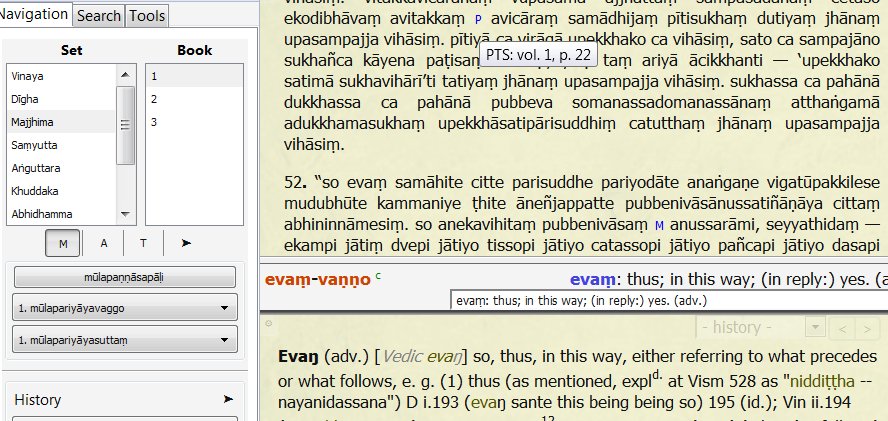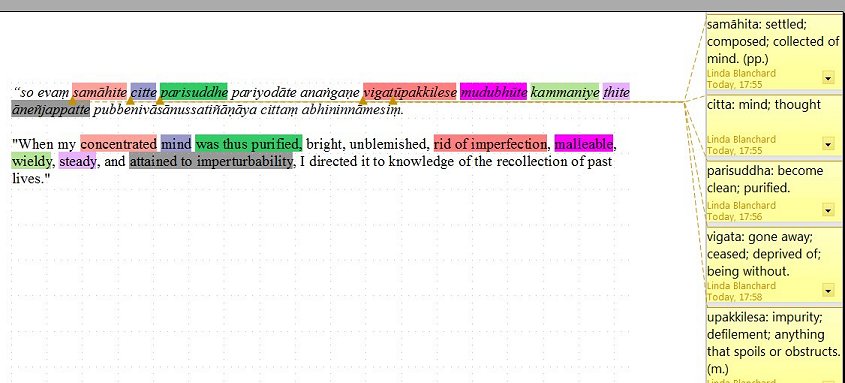Playing With Pali: Poking Under the Hood
I was not good at grammar in grade school, and I got no better at it in high school. I found all the terms and the rules to be counter-intuitive, a lot like geometric axioms. In both cases, it seemed like these were rules applied on top of things that should be understood in some entirely other way (in one’s bones). I could understand them while I worked with them or when I was in the middle of a course of study, but they instantly disappeared from my memory the second I turned my back for a moment. How bad I am at grammar will come as no surprise to those who understand grammar and enough Pali to feel pain when observing my ongoing dabbling in translation via my personal blog. The question they must be asking themselves — and you may well ask, too — is “Why does she bother?”
The reason is this: however bad at grammar I am, with my cheat sheet and the free tools that are readily-available via the internet, there is no better way to check the integrity of the translations I’m looking at than to poke around in the Pali that is the closest we will get — short of time travel — to the Buddha’s actual words.
Of course, I am fortunate, in that I am one of those people who learns best by doing. My mistakes may embarrass the scholars out there, but I love them because I learn — memorably — when they occur. It’s also good that I actually like words in general. If you do, too, and have any interest at all in a different sort of deeper study of the Buddha’s teachings (his “dhamma”), this is my invitation to you to get your hands dirty by poking under the hood of the translations that are readily available to us.
To begin, you really only need one tool — a wonderfully rich piece of software that is constantly enhanced by Noah Yuttadhammo — called “Digital Pali Reader” (DPR). This tool runs independently (once downloaded) on Firefox, and when you set it up, if you choose to also take on the Access To Insight database, this will give you the seamless ability to pull up the English equivalents of the texts you examine (if they are on the site). You can also gain access to the Dictionary of Pali Proper Names, as well.
It is glorious to have on hand, not only because it links to the English translations, but because it gives us access to the entire Pali canon in Pali, with one-click translations of the words (suggestions, anyway), and even, in many cases, one-more-click to the various inflections of the words into their various grammatical forms.
I’d like to give an example of why poking into the Pali is helpful. It will be best if you have the DPR loaded for this process (we’ll wait while you go get it, if you like), though it might be possible to follow along just with the screen shot and some imagination.
There are many reasons why messing around with the Pali is worth doing, too many to try to list, but just one quick poke into a phrase or two that is often encountered in reading translations of suttas might be enough of an example.
Let’s start with a piece of MN 4, in the section about how the Buddha came to his awakening:
“When my concentrated mind was thus purified, bright, unblemished, rid of imperfection, malleable, wieldy, steady, and attained to imperturbability, I directed it to knowledge of the recollection of past lives.” — MN 4.27 translated by Bhikkhus Nanamoli and Bodhi, p 105 of Wisdom Publications “Middle Length Discourses of the Buddha” (NOTE)
My question, on reading the above, is “How close a match are those words to what we find in the Pali?” I am particularly interested in the phrase “the recollection of past lives”. Before we can poke those words, though, we need to find them in the Pali.
The first thing we need to do is to get oriented in the text. A lot of poking of Pali words and comparing to the English text will get us there eventually, but the Wisdom Publications books make it a little easier by providing the page numbers of the Pali Text Society (“PTS”) versions and these are also marked in the DPR Pali texts. In the screen shot at the top of this article, in the box at the upper right, which is where the text of the sutta lies, you can see a little blue letter “P” which stands for “PTS” and hovering your cursor over that marker brings up the little box also shown in the image — it says “PTS: vol. 1, p. 22”. If you have the Wisdom Publications edition handy, you’ll find on its page 105, toward the top of the page, that the same number is referenced with [22] stuck between words.
The way I get to what we are looking for is to simply click on words after that [22] marker and look for something to match them in the text. Clicking on avicāraṃ gets us “a-vicāram” in red on the bar below, which also offers information about the prefix “a-” and then if we click on either the red “vicāram” or choose it in the drop down box to the right, we find it means “investigation” — which doesn’t seem too helpful — so let’s try clicking on the next word, samādhijaṃ, which comes up as “produced by concentration” which seems a good match for the words at the end of the same paragraph “born of concentration”.Keeping in mind that the word order in Pali is not going to match the order we put things in English, if we keep poking Pali and tracking forward through the text, we will eventually discover that catutthaṃ jhānaṃ means “fourth jhana” and that gets us to the paragraph just before the phrase we’re looking at.
(Note that this whole process gets easier and easier the more you do it. Plus, poking at all those words turns up wonderfully surprising things.)
Pali doesn’t actually come with commas and periods — in fact most of the words are run right into each other, so where they are broken into individuals in the versions we see is usually done by the editors as an aid to you and I, the beginners — but the provided punctuation usually does match what we find in the English translations, so that is a help. Since we are looking at the first sentence in this paragraph (marked “27” in the book, “52” in the DPR’s Pali text), and the word abhininnāmesiṃ has a period after it, that’s the sentence to work on:
“so evaṃ samāhite citte parisuddhe pariyodāte anaṅgaṇe vigatūpakkilese mudubhūte kammaniye ṭhite āneñjappatte pubbenivāsānussatiñāṇāya cittaṃ abhininnāmesiṃ.
I like to put a phrase like this into a word processing file where I can color-code and match the translator’s words to the ones I find in the Pali, like so:
This leaves us with that last long phrase pubbenivāsānussatiñāṇāya cittaṃ abhininnāmesiṃ meaning “I directed it to knowledge of the recollection of past lives.”
The word cittaṃ is the same as the above citte, “mind” which would be the “it” in the translation, “I directed it/my mind to…” When we click on abhininnāmesiṃ we find it means “to bend towards, to turn or direct” so that takes care of “I directed it to” — and that’s two out of three of the Pali words. We’re left with the impressively long pubbenivāsānussatiñāṇāya. When we click on that, on the right side of the bar we get the first part of the word translated:
pubbenivāsānussati: remembrance of one’s former state of existence. (f.)
but on the left side of the bar, we find that dictionary can’t parse the first part of the word but gets the second part (in red) okay:
Ñāṇa: knowledge, intelligence insight, conviction, recognition
A word as long as pubbenivāsānussati is usually a compound made up of smaller words, and finding out what those are can be revealing. The DPR tries to offer lots of possible ways to break it down but sometimes the options are too great to fit in the box. This time we get lucky, though, because in the phrase that follows immediately after we find the first part of the problematic term: pubbenivāsaṃ and when we click on that and open the drop-down box, we are offered lots of possible combinations. Trying just the first one — pubbe-nivāsaṃ — we find (by clicking on the red terms) that pubbe has been assigned a meaning, in compounds like this, of “in a former existence” but it has its stand-alone meaning as “abode in a former life, one’s former state of existence” — or as the blue text has it, “formerly; in the past”. And nivāsaṃ means “stopping, dwelling, resting — place, abode; living, sheltering”, and is given in this phrase as being “to remember one’s former abode or place of existence (in a former life)”. The root words actually say nothing about “a life” at all.
It is easy to conclude from the definition of pubbe in a compound as “in a former existence” that we are indeed talking about “in a past life”, but the question needs to be asked: who says that is what the word means? Who gave it that as a definition when nothing in the root says “a past life”? Was it someone who believed that that was what the Buddha was speaking about? With its uncompounded meaning of “formerly; in the past” combined with nivāsaṃ‘s “stopping, dwelling, resting — place, abode; living, sheltering” might the words actually indicate something far less specific than Bhikkhus Nanamoli and Bodhi’s translation “recollection of past lives” indicates? Even “in a former existence” might not indicate a literal past life; in one of my former existences, I was a sailor (I’m not a sailor in this existence, though).
*~*~*~*
I hope that this run-through of a readily-available (and free) tool — that lets even a beginner like myself satisfy my curiosity and check into the Pali — will encourage you to do the same. The words seem intimidating at first, but with such a wonderful piece of software that allows us to try different combinations to sort out meanings, it is much easier than it has ever been. To gain a better understanding of what the Buddha taught — to have the opportunity to see if what we are told he taught is, necessarily, the only interpretation — we will need many who are willing to dirty their hands under the hood.
If you are interested in learning more, please join us in the Discussion area of this site, where you’ll find a forum called “Learning Pali” — start a topic yourself if you have something to say that doesn’t fit what’s already there. And please feel free to comment, below, on this post — let me know if this was of interest and if you’d like more of the same (or something different but related).
*~*~*~*
NOTE: This sutta can also be found in a translation by Thanissaro Bhikkhu online, but it is not as easy to get oriented in his translations because he does not include the PTS page markers. Still, the more translations we have to look at, the merrier. His is:
“When the mind was thus concentrated, purified, bright, unblemished, rid of defilement, pliant, malleable, steady, & attained to imperturbability, I directed it to the knowledge of recollecting my past lives.“


